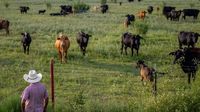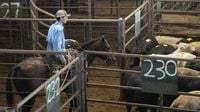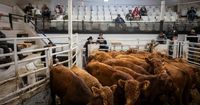President Donald Trump’s latest trade initiative—a plan to dramatically increase low-tariff beef imports from Argentina—has ignited a firestorm of criticism from American cattle ranchers, farm groups, and even some of his longtime political allies. The move, announced just weeks after a controversial $20 billion U.S. bailout for Argentina’s struggling economy, has left many in farm country feeling betrayed and worried about their future.
The National Cattlemen’s Beef Association (NCBA), which represents U.S. cattle producers, minced no words in its October 23, 2025, statement. Calling the proposal "misguided," NCBA CEO Colin Woodall declared, “The National Cattlemen’s Beef Association and its members cannot stand behind the President while he undercuts the future of family farmers and ranchers by importing Argentinian beef in an attempt to influence prices.” According to the NCBA, “efforts to manipulate markets only risk damaging the livelihoods of American cattlemen and women, while doing little to impact the price consumers are paying.”
The plan itself is sweeping: under current rules, Argentina can ship up to 20,000 metric tons of beef to the U.S. each year at a reduced tariff, with anything above that facing a 26.4% levy. The Trump administration now aims to quadruple that quota to 80,000 metric tons annually. As Agriculture Secretary Brooke Rollins explained on Fox Business, “Currently, Americans consume 12 million metric tons of beef. 10 million, we produce in this country. 2 million, we import. Out of 12 million, [the Argentine quota] would be 20,000 every quarter. This is not a massive influx in the millions of tons I think that some have thought of beef from Argentina.”
But for many U.S. ranchers, the numbers are cold comfort. Christian Lovell, an Illinois cattle farmer and senior director at Farm Action, a nonpartisan farm advocacy group, told CNN, “If Trump goes through with what he outlined, I do believe it’s a betrayal of the American rancher. It’s a feeling that you’re selling us out to a foreign competitor.”
President Trump, for his part, has defended the plan as a necessary response to soaring beef prices and as a way to help Argentina’s economy. Speaking to reporters on Air Force One, he said buying beef from Argentina “will bring our beef prices down” while also helping Argentina. On October 22, 2025, he took to Truth Social to address the backlash: “The Cattle Ranchers, who I love, don’t understand that the only reason they are doing so well, for the first time in decades, is because I put Tariffs on cattle coming into the United States, including a 50% Tariff on Brazil. It would be nice if they would understand that, but they also have to get their prices down, because the consumer is a very big factor in my thinking, also!”
Yet, the numbers tell a complex story. According to the NCBA, in the past five years, Argentina shipped beef valued at more than $800 million to the U.S., while purchasing only $7 million of U.S. beef in return—a glaring trade imbalance. “It is imperative that President Trump and Secretary of Agriculture Brooke Rollins let the cattle markets work,” the NCBA urged.
Members of Congress have also weighed in. Eight House Republicans from major cattle states sent a letter to the White House, seeking clarity on safety and inspection standards and questioning how the policy aligns with the administration’s promises to strengthen American agriculture. Senator James Lankford of Oklahoma told ABC News, “We’ve got all the folks that are ranchers in my state that are handling beef. They would tell you firsthand American beef is the best beef in the world. That’s why we work hard to be able to export it.”
Senator Chuck Grassley of Iowa, a senior Republican, echoed those concerns and went further, criticizing Trump’s social media outbursts. “The president would be better off if he’d keep his mouth shut on that issue and not tweet about it,” Grassley told reporters. He praised the USDA’s plan to expand cattle producers’ access to federal grazing land and increase meat processing capacity, but he warned that increased imports “would damage the incentive for U.S. cattlemen to raise more cattle,” adding, “undercutting American beef is not putting American first.”
Why are beef prices so high in the first place? Becca Jablonski, an agricultural economist at Cornell University, explained to CNN that a multi-year drought has reduced grazing land and driven up feed costs, leading to a shortage of cattle. This shortage has been compounded by an infestation of New World screwworm—a flesh-eating parasite—just across the border in Mexico, which has further limited beef imports from that country. As a result, beef prices have soared nearly 14% in the past year, according to Bureau of Labor Statistics data from August.
Despite these high prices, many ranchers argue that this is the first profitable year they’ve had in decades. “I think the argument the industry is making is, ‘Let us have one good year,’” Jablonski said. Lovell added, “It is not uncommon for folks in farming to have a year where they report a loss. You cannot look at cattle producers that had one good year and say, ‘Oh my gosh, they are just making out like bandits.’”
Meanwhile, the administration has tried to soften the blow with new USDA initiatives. Announced on October 22, 2025, the plan aims to expand ranchers’ access to federal grazing land and prioritize grant applications for military veterans looking to enter the industry. White House spokesperson Anna Kelly said, “President Trump pledged to protect America’s ranchers and deliver economic relief for everyday Americans. The Administration is accomplishing both by expanding beef imports from Argentina to lower consumer prices in the short term while rolling out a new USDA initiative that will support ranchers and expand cattle herd sizes to keep prices lower in the long term.”
But not everyone is convinced. The Iowa Cattlemen’s Association called the president’s rhetoric “disconcerting,” warning that it creates “undue harm to U.S. cattle producers, inhibiting their ability to make smart marketing decisions that directly impact their long-term profitability.” Brent Johnson, president of the Iowa Farm Bureau Federation, urged the administration to “resist actions that negatively impact the cattle farmers in Iowa and domestic beef production.”
The controversy comes as U.S. agriculture faces broader challenges. The trade war with China has hit soybean farmers hard, with China halting purchases of American soybeans and Argentina removing export tariffs after receiving the U.S. bailout. “Now nobody’s buying it,” John Boyd, president of the National Black Farmers Association, told CNN. “The president thinks his tariffs are the best thing since sliced bread, and it’s putting America’s farmers out of business.”
With farm bankruptcies on the rise and the government shutdown stretching on, the administration has floated a new multibillion-dollar bailout for U.S. farmers, but no concrete plan has emerged. For many in rural America, the sense of uncertainty is palpable—and the debate over Argentinian beef is just the latest flashpoint.
As the dust settles, American ranchers and farmers are left wondering if their interests are truly being put first, or if they’re being asked to sacrifice for the sake of lower grocery bills and foreign policy gambits. For now, the only certainty is that the battle over beef—and the future of American agriculture—shows no sign of cooling off.


